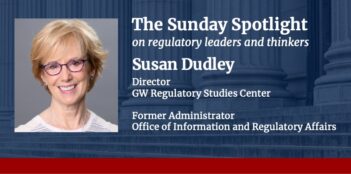
The Biden Administration can deliver its policy agenda through progressive, people-centered regulatory reform.
Many factors will determine whether President-Elect Joe Biden and Vice President-Elect Kamala Harris can deliver on their policy agenda, but few are as important as their ability to leverage the federal regulatory system. Given the prospect of a divided U.S. Congress, the most viable path for significant progress is through effective implementation of existing statutory authorities. We urge Biden and Harris to institute fundamental cross-cutting reforms for building a people-centered regulatory system that is fairer, more equitable, and more effective.
Upon assuming office in January, Biden and Harris will face a daunting confluence of policy crises, including the COVID-19 pandemic and the ensuing economic downturn, systemic racial injustice, widening economic inequality, and an accelerating climate crisis. The task of managing these crises will be made more difficult by the fact that the Administration will inherit a regulatory system that has been battered by decades of neglect followed by four years of outright attack from the Trump Administration.
But time is of the essence.
Biden and Harris must make full use of the regulatory system—even while they repair the damage. With this context in mind, we favor overhauling what is perhaps the single most important federal regulatory policy outside of the Administrative Procedure Act: the system of centralized regulatory review by the White House Office of Information and Regulatory Affairs (OIRA).
When the Reagan Administration first instituted OIRA, the practice of regulatory review was widely viewed as a cynical ploy to undermine regulatory safeguards. President Bill Clinton’s Executive Order 12,866 attempted a course correction, but, over time, the system has largely devolved into a backdoor channel for industry lobbyists seeking to weaken regulations for financial gain.
During this time, a hyper-formalistic version of cost-benefit analysis has also become more entrenched in White House and agency culture. Consistent with its grounding in neoliberal orthodoxy, this version of cost-benefit analysis demands a misleading and artificial monetization of non-market goods and remains narrowly focused on an ideal of aggregate social wealth maximization. Among a host of other problems, this ideal is fundamentally at odds with the attention to existing disparities in wealth and power that this political moment demands.
We have recently issued six sets of recommendations to the transition team. The first set re-envisions OIRA as a champion of a new, more constructive vision of regulation—one that sees standards and safeguards as essential tools for providing public goods and affirmatively supports the Biden-Harris policy agenda through agency rulemaking. A necessary first step is the establishment of a more constrained approach to OIRA’s process of regulatory review so that it focuses on interagency coordination and ensures the legal and procedural soundness of agency rules. In addition to urging OIRA to increase its staff diversity, we would charge it with articulating a new progressive vision of regulation and putting that vision into practice.
The second set of recommendations outlines a strategy for realigning cost-benefit analysis to make it more consistent with social justice, equity, and other progressive principles. We suggest reaffirming the primacy of agencies and their statutory missions in regulatory decision-making by empowering agencies to assess the costs and benefits of their rules according to the context-specific methods outlined in their authorizing statutes. We also endorse new practices that better account for unquantifiable impacts, as well as steps for elevating distributional considerations, justice, and equity in agency analyses.
The third set of recommendations takes a closer look at the specific tasks OIRA should undertake to support a progressive vision of regulation and the effective, expeditious development of new protective safeguards. These tasks include identifying emerging hazards to people and the environment to address; developing cross-cutting regulatory reform proposals that would enable agencies to carry out their responsibilities in a more timely and effective manner; and training agency leaders to use alternative policymaking tools to ensure robust and responsive implementation of regulatory programs.
The fourth set of recommendations addresses the challenge of de-politicizing OIRA and insulating it from improper political interference. Numerous factors have led to OIRA’s politicization, including the steadily increasing power it wields over the substance of agency rules, as well as the general lack of transparency that enables it to operate free of public scrutiny. We propose constraining OIRA’s power by restricting its review authority as well as strengthening its transparency requirements.
The fifth set of recommendations focuses on how to overcome the significant data limitations agencies face when analyzing potential regulatory impacts. These data gaps render the hyper-formalistic version of cost-benefit analysis all but impossible to perform in a credible manner, and they skew the results against strong safeguards. Accordingly, we advise that agencies be permitted to use alternative tools to assess regulatory costs and benefits so they can more closely match their existing statutory authorities and better accommodate significant data gaps.
The sixth and final set of recommendations considers the irrational and unscientific techniques agencies employ to convert regulatory impacts into dollars and cents. The U.S. Department of Justice’s infamous attempt to place a monetary value on the prevention of prison rape illustrates this problem. We recommend the use of alternative approaches that do not rely on monetization of non-market impacts or require calculation of net benefits. These approaches should ensure a robust and nuanced depiction of the consequences of regulation through qualitative terms that maintain “the richness and diversity of what is at stake, and for whom.” They would guarantee, for example, consideration of the interrelated “benefits” of regulations that protect “essential” workers, enable them to earn a living and support their children, and reduce disease in their communities. They also would help address systemic inequalities that result in Black, Latinx, and low-wealth people disproportionately bearing the risks of working in jobs deemed “essential.”
Much more work is required to build a truly progressive and people-centered regulatory system. But a new, cross-cutting executive order on regulatory review would offer an essential first step.
Center for Progressive Reform member scholars Catherine O’Neill and Sidney Shapiro also contributed to the development of the recommendations discussed in this essay.





